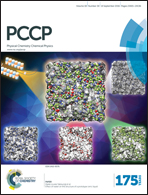Direct phase coexistence molecular dynamics study of the phase equilibria of the ternary methane–carbon dioxide–water hydrate system
Abstract
Molecular dynamics simulation is used to predict the phase equilibrium conditions of a ternary hydrate system. In particular, the direct phase coexistence methodology is implemented for the determination of the three-phase coexistence temperature of the methane–carbon dioxide–water hydrate system at elevated pressures. The TIP4P/ice, TraPPE-UA and OPLS-UA forcefields for water, carbon dioxide and methane respectively are used, in line with our previous studies of the phase equilibria of the corresponding binary hydrate systems. The solubility in the aqueous phase of the guest molecules of the respective binary and ternary systems is examined under hydrate-forming conditions, providing insight into the predictive capability of the methodology as well as the combination of these forcefields to accurately describe the phase behavior of the ternary system. The three-phase coexistence temperature is calculated at 400, 1000 and 2000 bar for two compositions of the methane–carbon dioxide mixture. The predicted values are compared with available calculations with satisfactory agreement. An estimation is also provided for the fraction of the guest molecules in the mixed hydrate phase under the conditions examined.



 Please wait while we load your content...
Please wait while we load your content...